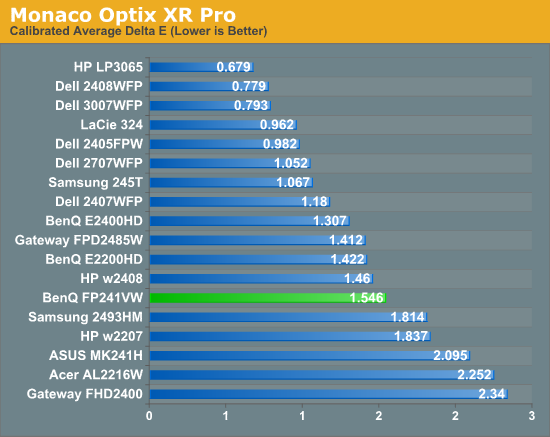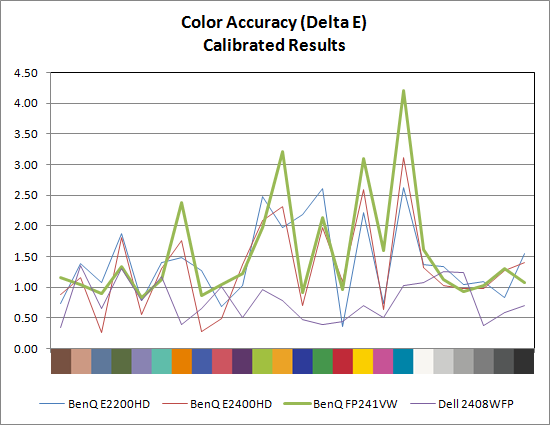Color Accuracy
Imaging professionals definitely like to have accurate colors, and the best way of assuring that your display shows the proper colors is to use a colorimeter and calibration software. However, not everyone has access to such tools and many users are unwilling to spend over $200, so we calibrate and test the various LCDs. We didn't perform a thorough evaluation of color accuracy on the FP241VW, so we will limit our Delta E comparison to calibrated performance where we target a white level of ~200 nits - anything more than that is too bright in our opinion. The FP241VW actually ended up at 270 nits, but that won't substantially affect any of the scores. Before we get to the results, here are the display settings we used on the BenQ LCDs. We let the LCDs stabilize for at least one hour before performing measurements. We will compare results with the Dell 2408WFP, which so far has achieved the best overall color accuracy of any LCD we have tested, as well as the previous two BenQ LCDs.
| LCD Brightness and Contrast Settings | ||
| Standard Calibrated (~200 nits) | Calibrated for Print (~100 nits) | |
| BenQ E2200HD | 65 Brightness, 50 Contrast "Normal" (95-95-95 RGB) |
20 Brightness, 50 Contrast "Normal" (95-95-95 RGB) |
| BenQ E2400HD | 73 Brightness, 50 Contrast "Normal" (94-94-91 RGB) |
30 Brightness, 50 Contrast "Normal" (94-94-91 RGB) |
| BenQ FP241VW | 35 Brightness, 50 Contrast (270 nits) "Normal/sRGB" (47-48-45 RGB) |
N/A |


After calibration, the FP241VW still fails to come anywhere close to the Dell 2408WFP - and in fact it doesn't even match the accuracy of the less expensive E2400HD. That said, it's interesting to note that the color accuracy curves for all three BenQ LCDs are extremely similar, to the point where I now have to wonder if backlighting has a far greater impact on color accuracy than I previously thought. It makes sense that better backlighting would allow the panels to achieve better color accuracy, but I don't have any evidence for this assertion other than the above chart. Anyone serious about color accuracy is probably going to want an average Delta E of around 1.0 or less post-calibration. So far, only S-PVA and S-IPS panels achieve that goal, although it's possible a better backlight would allow the A-MVA display to match the other displays. Note also how the bottom half of the above chart is dominated by LCDs that use TN panels.










114 Comments
View All Comments
Guntherman - Wednesday, June 17, 2009 - link
I would love to see a review of this. I personally have one and I couldn't be happier with it. Plus with it being ~$200 it's a great deal.blyndy - Wednesday, June 17, 2009 - link
I have been keenly looking out for e-IPS monitors because they're supposed to be the 'new wave' of high-quality affordable LCDs, and the Dell '2209WA' e-IPS lived up to expectations judging by the good reviews, but it's too small for me.I was glad to see on Wikipedia's page of "Dell monitors" the 24" e-IPS '2410WA' listed with 1920×1200 and DisplayPort, OMFG sounds perfect!
SirKronan - Wednesday, June 17, 2009 - link
Wow, that's one I'm definitely going to have to look up! Thanks for the tip.JarredWalton - Wednesday, June 17, 2009 - link
It would be hard for it to be *worse* than TN, but there aren't a lot of E-IPS displays right now. Maybe you're right and that will change; that's my hope. There are other IPS displays available (HP's 24" IPS model for example), but the trend is definitely towards TN panels right now. Boo!